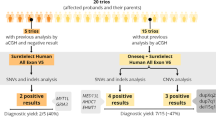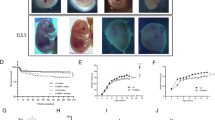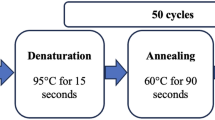Abstract
Obesity is a common but highly, clinically, and genetically heterogeneous disease. Deletion of the terminal region of the short arm of chromosome 2 is rare and has been reported in about 13 patients in the literature often associated with a Prader–Willi-like phenotype. We report on five unrelated patients with 2p25 deletion of paternal origin presenting with early-onset obesity, hyperphagia, intellectual deficiency, and behavioural difficulties. Among these patients, three had de novo pure 2pter deletions, one presented with a paternal derivative der(2)t(2;15)(p25.3;q26) with deletion in the 2pter region and the last patient presented with an interstitial 2p25 deletion. The size of the deletions was characterized by SNP array or array-CGH and was confirmed by fluorescence in situ hybridization (FISH) studies. Four patients shared a 2p25.3 deletion with a minimal critical region estimated at 1.97 Mb and encompassing seven genes, namely SH3HYL1, ACP1, TMEMI8, SNTG2, TPO, PXDN, and MYT1L genes. The fifth patient had a smaller interstitial deletion encompassing the TPO, PXDN, and MYT1L genes. Paternal origin of the deletion was determined by genotyping using microsatellite markers. Analysis of the genes encompassed in the deleted region led us to speculate that the ACP1, TMEM18, and/or MYT1L genes might be involved in early-onset obesity. In addition, intellectual deficiency and behavioural troubles can be explained by the heterozygous loss of the SNTG2 and MYT1L genes. Finally, we discuss the parent-of-origin of the deletion.
Similar content being viewed by others
Log in or create a free account to read this content
Gain free access to this article, as well as selected content from this journal and more on nature.com
or
References
Schinzel A : Catalogue of Unbalanced Chromosome Aberrations in Man, 2nd rev. and expanded (edn). Walter de Gruyter: Berlin; New York, 2001.
Czako M, Riegel M, Morava E, Bajnoczky K, Kosztolanyi G : Opitz ‘C’ trigonocephaly-like syndrome in a patient with terminal deletion of 2p and partial duplication of 17q. Am J Med Genet A 2004; 131: 310–312.
Ravnan JB, Tepperberg JH, Papenhausen P et al: Subtelomere FISH analysis of 11 688 cases: an evaluation of the frequency and pattern of subtelomere rearrangements in individuals with developmental disabilities. J Med Genet 2006; 43: 478–489.
Zou YS, Van Dyke DL, Ellison JW : Microarray comparative genomic hybridization and FISH studies of an unbalanced cryptic telomeric 2p deletion/16q duplication in a patient with mental retardation and behavioral problems. Am J Med Genet A 2007; 143: 746–751.
Wu Y, Ji T, Wang J et al: Submicroscopic subtelomeric aberrations in Chinese patients with unexplained developmental delay/mental retardation. BMC Med Genet 2010; 11: 72.
Becker K, Jaggard C, Horrocks S : A novel presentation of a rare chromosome 2p25.2 deletion. Clin Dysmorphol 2010; 19: 101–102.
Stevens SJ, van Ravenswaaij-Arts CM, Janssen JW et al: MYT1L is a candidate gene for intellectual disability in patients with 2p25.3 (2pter) deletions. Am J Med Genet A 2011; 155A: 2739–2745.
Rio M, Royer G, Gobin S et al: Monozygotic twins discordant for submicroscopic chromosomal anomalies in 2p25.3 region detected by array CGH. Clin Genet 2012; 84: 31–36.
Paggi A, Borgiani P, Gloria-Bottini F et al: Further studies on acid phosphatase in obese subjects. Dis Markers 1991; 9: 1–7.
De Lorenzo A, Di Renzo L, Puja A, Saccucci P, Gloria-Bottini F, Bottini E : A study of acid phosphatase locus 1 in women with high fat content and normal body mass index. Metabolism 2009; 58: 351–354.
Thorleifsson G, Walters GB, Gudbjartsson DF et al: Genome-wide association yields new sequence variants at seven loci that associate with measures of obesity. Nat Genet 2009; 41: 18–24.
Almen MS, Jacobsson JA, Shaik JH et al: The obesity gene, TMEM18, is of ancient origin, found in majority of neuronal cells in all major brain regions and associated with obesity in severely obese children. BMC Med Genet 2010; 11: 58.
Peterfi Z, Donko A, Orient A et al: Peroxidasin is secreted and incorporated into the extracellular matrix of myofibroblasts and fibrotic kidney. Am J Pathol 2009; 175: 725–735.
Nagase T, Seki N, Ishikawa K et al: Prediction of the coding sequences of unidentified human genes. VI. The coding sequences of 80 new genes (KIAA0201-KIAA0280) deduced by analysis of cDNA clones from cell line KG-1 and brain. DNA Res 1996; 3: 321–329, 341-354.
Yamakawa H, Oyama S, Mitsuhashi H et al: Neuroligins 3 and 4X interact with syntrophin-gamma2, and the interactions are affected by autism-related mutations. Biochem Biophys Res Commun 2007; 355: 41–46.
Rosenfeld JA, Ballif BC, Torchia BS et al: Copy number variations associated with autism spectrum disorders contribute to a spectrum of neurodevelopmental disorders. Genet Med 2010; 12: 694–702.
Kim JG, Armstrong RC, v Agoston D et al: Myelin transcription factor 1 (Myt1) of the oligodendrocyte lineage, along with a closely related CCHC zinc finger, is expressed in developing neurons in the mammalian central nervous system. J Neurosci Res 1997; 50: 272–290.
Lee Y, Mattai A, Long R, Rapoport JL, Gogtay N, Addington AM : Microduplications disrupting the MYT1L gene (2p25.3) are associated with schizophrenia. Psychiatr Genet 2012; 22: 206–209.
Vrijenhoek T, Buizer-Voskamp JE, van der Stelt I et al: Recurrent CNVs disrupt three candidate genes in schizophrenia patients. Am J Hum Genet 2008; 83: 504–510.
Wang T, Zeng Z, Li T et al: Common SNPs in myelin transcription factor 1-like (MYT1L): association with major depressive disorder in the Chinese Han population. PLoS One 2010; 5: e13662.
Bakker B, Bikker H, Vulsma T, de Randamie JS, Wiedijk BM, De Vijlder JJ : Two decades of screening for congenital hypothyroidism in The Netherlands: TPO gene mutations in total iodide organification defects (an update). J Clin Endocrinol Metab 2000; 85: 3708–3712.
Ris-Stalpers C, Bikker H : Genetics and phenomics of hypothyroidism and goiter due to TPO mutations. Mol Cell Endocrinol 2010; 322: 38–43.
Fugazzola L, Persani L, Mannavola D et al: Recombinant human TSH testing is a valuable tool for differential diagnosis of congenital hypothyroidism during L-thyroxine replacement. Clin Endocrinol (Oxf) 2003; 59: 230–236.
Lukusa T, Fryns JP : Pure de novo 17q25.3 micro duplication characterized by micro array CGH in a dysmorphic infant with growth retardation, developmental delay and distal arthrogryposis. Genet Couns 2010; 21: 25–34.
Acknowledgements
This work was supported by ACLF telomere network (promoter Bordeaux Hospital), the national array-CGH network funded by the French Ministry of Health, and the AOL 2001 project (Reims Hospital), France. This work was supported by grants AOL 2001-2003 CHU Reims and PHRC 2003-2005 CHU-REIMS, and Promoter CHU-Bordeaux France, ACLF réseau télomère. This work was also spported by the grant PHRC N°2007-AOO642-51 CHU Montpellier.
Author information
Authors and Affiliations
Corresponding author
Ethics declarations
Competing interests
The authors declare no conflict of interest.
Rights and permissions
About this article
Cite this article
Doco-Fenzy, M., Leroy, C., Schneider, A. et al. Early-onset obesity and paternal 2pter deletion encompassing the ACP1, TMEM18, and MYT1L genes. Eur J Hum Genet 22, 471–479 (2014). https://doi.org/10.1038/ejhg.2013.189
Received:
Revised:
Accepted:
Published:
Issue date:
DOI: https://doi.org/10.1038/ejhg.2013.189
Keywords
This article is cited by
-
Myt1l haploinsufficiency leads to obesity and multifaceted behavioral alterations in mice
Molecular Autism (2022)
-
MYT1L-associated neurodevelopmental disorder: description of 40 new cases and literature review of clinical and molecular aspects
Human Genetics (2022)
-
Chromosomal microarray analysis in the genetic evaluation of 279 patients with syndromic obesity
Molecular Cytogenetics (2018)
-
IGIACP1 predicts the prognosis in multiple myeloma patients
Oncology and Translational Medicine (2017)
-
Associations of the Intellectual Disability Gene MYT1L with Helix–Loop–Helix Gene Expression, Hippocampus Volume and Hippocampus Activation During Memory Retrieval
Neuropsychopharmacology (2017)



